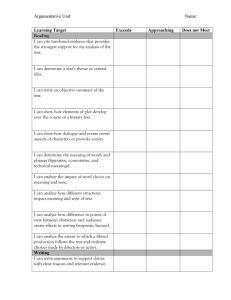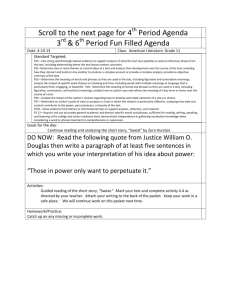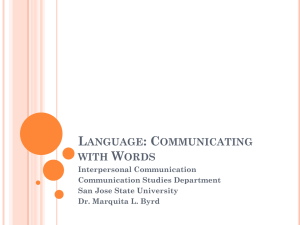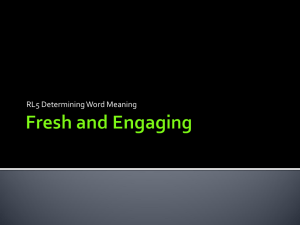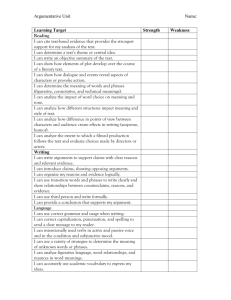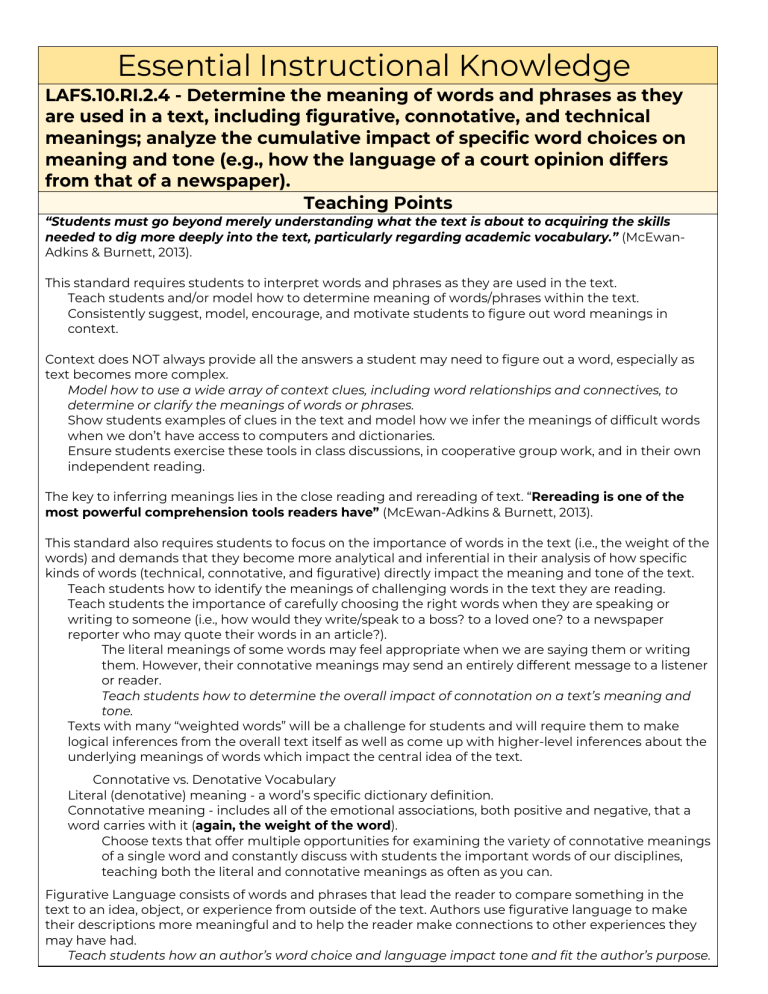
Essential Instructional Knowledge LAFS.10.RI.2.4 - Determine the meaning of words and phrases as they are used in a text, including figurative, connotative, and technical meanings; analyze the cumulative impact of specific word choices on meaning and tone (e.g., how the language of a court opinion differs from that of a newspaper). Teaching Points “Students must go beyond merely understanding what the text is about to acquiring the skills needed to dig more deeply into the text, particularly regarding academic vocabulary.” (McEwanAdkins & Burnett, 2013). This standard requires students to interpret words and phrases as they are used in the text. Teach students and/or model how to determine meaning of words/phrases within the text. Consistently suggest, model, encourage, and motivate students to figure out word meanings in context. Context does NOT always provide all the answers a student may need to figure out a word, especially as text becomes more complex. Model how to use a wide array of context clues, including word relationships and connectives, to determine or clarify the meanings of words or phrases. Show students examples of clues in the text and model how we infer the meanings of difficult words when we don’t have access to computers and dictionaries. Ensure students exercise these tools in class discussions, in cooperative group work, and in their own independent reading. The key to inferring meanings lies in the close reading and rereading of text. “Rereading is one of the most powerful comprehension tools readers have” (McEwan-Adkins & Burnett, 2013). This standard also requires students to focus on the importance of words in the text (i.e., the weight of the words) and demands that they become more analytical and inferential in their analysis of how specific kinds of words (technical, connotative, and figurative) directly impact the meaning and tone of the text. Teach students how to identify the meanings of challenging words in the text they are reading. Teach students the importance of carefully choosing the right words when they are speaking or writing to someone (i.e., how would they write/speak to a boss? to a loved one? to a newspaper reporter who may quote their words in an article?). The literal meanings of some words may feel appropriate when we are saying them or writing them. However, their connotative meanings may send an entirely different message to a listener or reader. Teach students how to determine the overall impact of connotation on a text’s meaning and tone. Texts with many “weighted words” will be a challenge for students and will require them to make logical inferences from the overall text itself as well as come up with higher-level inferences about the underlying meanings of words which impact the central idea of the text. Connotative vs. Denotative Vocabulary Literal (denotative) meaning - a word’s specific dictionary definition. Connotative meaning - includes all of the emotional associations, both positive and negative, that a word carries with it (again, the weight of the word). Choose texts that offer multiple opportunities for examining the variety of connotative meanings of a single word and constantly discuss with students the important words of our disciplines, teaching both the literal and connotative meanings as often as you can. Figurative Language consists of words and phrases that lead the reader to compare something in the text to an idea, object, or experience from outside of the text. Authors use figurative language to make their descriptions more meaningful and to help the reader make connections to other experiences they may have had. Teach students how an author’s word choice and language impact tone and fit the author’s purpose. How does language in an editorial differ from that of a newspaper article? Sample Question Stems ● ● ● ● ● ● ● Which words or phrases from the text provide support for the differential meaning of words with similar denotations? Cite specific evidence. How does the author use words with similar connotations to make connections and express ideas? Cite specific evidence. How does a word or phrase affect the meaning or tone of a text? Cite specific examples. How does the author use figurative language to advance the purpose in the text? Cite specific evidence. Read paragraph (2). Part A: What does the term ____ mean as used in this paragraph? Part B: Which words from the paragraph help provide the meaning? Read the excerpt from [piece of text]. Based on the phrase ________________, how did __________. Which phrase from the excerpt provides a clue to the meaning of ___________? Academic Vocabulary Word analyze clarify connotation/ connotative language context demonstrate denotation domain-specific words figurative language identify infer opinion nuance phrase relationship sufficient Definition to study or examine something in detail in order to discover more about it to make or become more easily understood language that communicates a feeling or idea that is suggested by a word in addition to its basic meaning, or something suggested by an object or situation 1. the situation within which something exists or happens, and that can help explain it 2. the text or speech that comes immediately before and after a particular phrase or piece of text and helps to explain its meaning 1. to show or make something clear 2. to show something and explain how it works the meaning of a word or phrase, usually as defined by a dictionary words specific to a field of study that help the reader understand a new concept 1. language expressing one thing in terms normally denoting another with which it may be regarded as analogous 2. language characterized by figures of speech to recognize or be able to name someone or something, or to prove who or what someone or something is 1. to form an opinion from evidence 2. to reach a conclusion based on known facts 1. a belief, judgment, or way of thinking about something 2. what someone thinks about a particular thing a very small difference in color, tone, meaning, etc. 1. a group of two or more words that express a single idea but do not usually form a complete sentence 2. a brief expression that is commonly used the way in which two or more people or things are connected having or providing as much as needed Synonyms breakdown, deconstruct, dissect clear up, construe, explain, explicate, expound, get across, illuminate, simplify overtone, significance, undertone, association, essence, hint, nuance, suggestion background, situation, text, frame of reference establish, prove, show, substantiate, validate meaning, name, definition disciplinary vocabulary metaphor, allegory, emblem, symbolism, euphemism, nonliteral language distinguish, pinpoint, single out, determine decide, deduce, derive, extrapolate, gather, judge belief, conviction, feeling, judgment, sentiment, verdict, view distinction, gradation, hint, implication, refinement, subtlety expression, idiom, motto, remark, saying, wording link, connection, affiliation, tie enough, adequate, competent tone a quality, feeling, or attitude expressed by the words that someone uses in speaking or writing manner, style, character, nature, vein, mode
